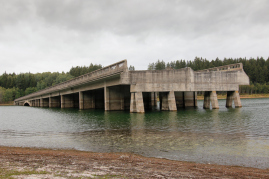Featured
Mark Mitchell: Bridges Need Blueprints

By Mark Mitchell
Degenerate Serial Entrepreneur
January 25, 2017 — Santa Cruz, CA
Over the last year, I’ve observed a recurring pattern:
- A pre-revenue (or low-revenue) start-up pitches an exciting new product or service. The start-up asks for a seed investment, with a budget showing that the new capital will provide approximately 18 months of runway. Projections show the start-up achieving target metrics for revenue, active users, customers, or the like within a year. After those milestones are reached, the start-up plans to raise additional financing at a significantly higher valuation.
- The team is impressive, the market seems substantial, and due diligence indicates that potential customers are eager to work with the start-up. Investors invest.
- 15 months later, the start-up is back. Everything is going great — but the software development scheduled slipped and the pilot customer loves the product but can’t make a decision on a purchase because of a management transition. The company’s success is inevitable. It just needs more time — and, therefore, more capital. Would the initial investors please provide a “bridge” investment?
My question is always “A bridge to where, exactly?”
It’s hard — for both companies and investors — to avoid the scenario above. Even entrepreneurs with extensive experience tend to underestimate difficulty, and Donald Rumsfeld‘s famous unknown unknowns crop up all too often.
For fear of dilution, founders are often reluctant to raise any more capital than seems absolutely necessary. And, raising a bigger round is difficult; if it’s hard to raise $1M, it’s even harder to raise $2M. Attracting more investors may require raising money at a lower valuation, which is doubly dilutive.
Because investors fear that founders without a meaningful stake (after follow-on fundraising) may not stay with the company, the company’s stage limits the amount of money it can raise. If a company needs $2m to reach its next milestone, it needs to be worth more than $5M, and that may well require more evidence of traction than the start-up can present.
Investors also have reasons to participate in rounds that may be too small. If the founder has enough other interest, investors have to choose between (a) the risk that the start-up runs out of money before reaching its milestones, and (b) missing out on an otherwise-attractive opportunity.
Anyhow, for one reason or another, companies regularly find themselves in the “we just need more time” situation, and at that point they seek more capital from existing investors.
Companies raising bridge financing often use a pitch similar to that for their initial raise. They explain their product or service, provide evidence that there is a large market, describe the background of key employees, show evidence of traction. When the company did their initial pitch, these elements formed a compelling story: brilliant people identified a great opportunity, and just needed capital. But, as the initial pitch included projections, and as those projections proved incorrect, the vision that still seems so powerful to the founders seems less inevitable to investors.
Therefore, I always encourage start-ups in this stage to provide a plan showing milestones that are (largely) under the start-up’s control and achievable with the new capital. For example, if early customers said that they would buy the start-up’s software if only it included a particular feature, then it is rational to invest the capital required to develop that feature. If the company needs more active users to drive follow-on investment, and the start-up has proven that online advertising drives user growth, then it is rational to invest the capital required to fund that advertising effort. But, if the company can only say that they need to do more software development, or that they need to hire an experienced VP of marketing, I am not likely to invest.
Even pitch deck includes a slide titled “Use of Funds.” For a company seeking a bridge investment, that slide should not be a pie chart showing how much money will be allocated to what expense categories; it should be a list of milestones and associated costs.
If you’re asking me to help you build a bridge, I want to see blueprints.
This article was originally published here: https://markmitchell.com/2017/01/23/bridges-need-blueprints/
More about Mark Mitchell here: https://www.linkedin.com/in/markpmitchell/
###
Tagged Mark Mitchell







